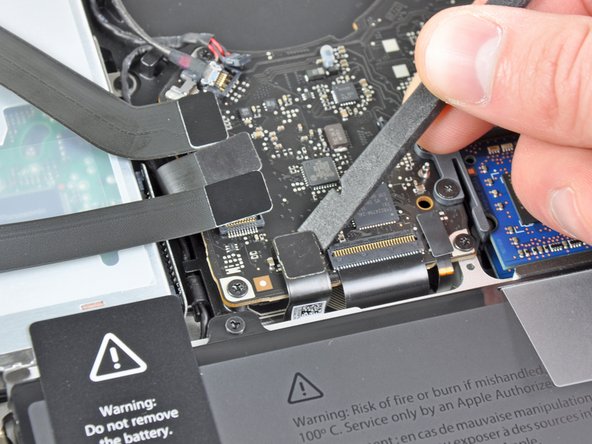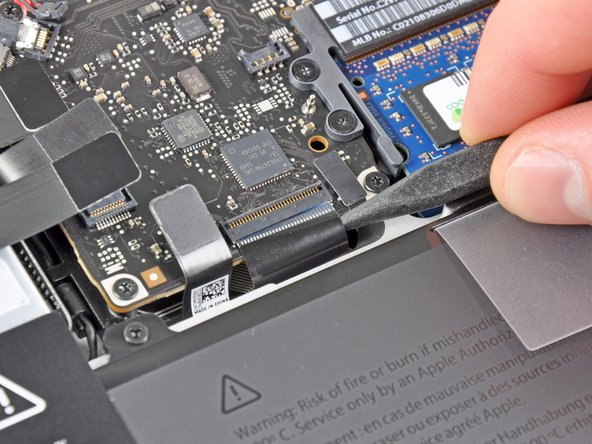Introduction
This guide will help you replace the logic board.
-
-
Remove the following ten screws:
-
Three 14.4 mm Phillips #00 screws
-
Three 3.5 mm Phillips #00 screws
-
Four 3.5 mm shouldered Phillips #00 screws
-
When replacing the small screws, align them perpendicular to the slight curvature of the case (they don't go straight down).
-
-
-
Use your fingers to pry the lower case away from the body of the MacBook near the vent.
-
Remove the lower case.
-
-
-
Use the edge of a spudger to pry the battery connector upwards from its socket on the logic board.
-
It is useful to pry upward on both short sides of the connector to "walk" it out of its socket. Be careful with the corners of the connectors, they can be easily broken off.
-
-
-
Bend the battery cable slightly away from its socket on the logic board so it does not accidentally connect itself while you work.
-
-
-
Use the edge of a spudger to gently pry the fan connector up and out of its socket on the logic board.
-
It is useful to twist the spudger axially from beneath the fan cable wires to release the connector.
-
The fan socket and the fan connector can be seen in the second and third pictures. Be careful not to break the plastic fan socket off the logic board as you use your spudger to lift the fan connector straight up and out of its socket. The layout of the logic board shown in the second picture may look slightly different than your machine but the fan socket is the same.
-
-
-
Remove the following three screws securing the fan to the logic board:
-
One 7.2 mm T6 Torx screw
-
Two 5.3 mm T6 Torx screws
-
-
-
Lift the fan out of its recess in the logic board, minding its cable that may get caught.
-
-
-
Use the tip of a spudger to pull the right speaker/subwoofer cable out from under the retaining finger molded into the upper case.
-
Pull the right speaker/subwoofer cable upward to lift the connector out of its socket on the logic board.
-
-
-
Disconnect the camera cable from the logic board.
-
Pull the cable parallel to the face of the logic board. Pulling the cable upward may damage the logic board or the cable itself.
-
-
-
Disconnect the following four cables:
-
AirPort/Bluetooth cable
-
Optical drive cable
-
Hard drive cable
-
Trackpad cable
-
To disconnect the cables, use the flat end of a spudger to pry their connectors up from the sockets on the logic board.
-
-
-
Use your fingernail to flip up the retaining flap on the keyboard ribbon cable ZIF socket.
-
Be sure you are prying up on the hinged retaining flap, not the socket itself.
-
Use the tip of a spudger to pull the keyboard ribbon cable out of its socket.
-
The cable may be difficult to insert. If you are having trouble, temporarily attach a piece of tape to the cable to help you guide the cable into the socket.
-
-
-
If present, remove the small strip of black tape covering the keyboard backlight cable socket.
-
-
-
Use the tip of a spudger or your fingernail to flip up the retaining flap on the keyboard backlight ribbon cable ZIF socket.
-
Be sure you are prying up on the hinged retaining flap, not the socket itself.
-
Pull the keyboard backlight ribbon cable out of its socket.
-
-
-
Use the flat end of a spudger to pry the sleep sensor/battery indicator connector up from its socket on the logic board.
-
-
-
Grab the plastic pull tab secured to the display data cable lock and rotate it toward the DC-In side of the computer.
-
Pull the display data cable straight out of its socket on the logic board.
-
Do not lift up on the display data cable, as its socket is very fragile. Pull the cable parallel to the face of the logic board.
-
-
-
Remove the following nine screws:
-
Five 3.6 mm T6 Torx screws
-
Two 4.3 mm T6 Torx screws
-
Two 7.2 mm T6 Torx screws
-
In some models the screws may be slightly shorter as follows:
-
Five 3.0 mm T6 screws
-
Two 3.6 mm T6 screws
-
Two 6.7 mm T6 screws
-
-
-
Remove the following two screws:
-
One 8.6 mm Phillips screw
-
One 5.5 mm Phillips screw
-
Remove the display data cable retainer from the upper case.
-
-
-
Use the tip of a spudger to gently peel the microphone off the adhesive securing it to the upper case.
-
-
-
Minding the many connectors near its edges, lift the logic board from the end nearest the optical drive.
-
Without flexing the board, maneuver it out of the upper case, minding the flexible connection to the DC-In board that may get caught in the upper case.
-
Remove the logic board.
-
-
-
De-route the microphone cable from its slot molded into the left speaker enclosure.
-
-
-
Remove the small piece of black tape covering the left speaker connector.
-
-
-
Use the flat end of a spudger to pry the left speaker connector up from its socket on the logic board.
-
Pry up from beneath the wires.
-
-
-
Carefully pry the left speaker off the foam adhesive securing it to the logic board.
-
Remove the left speaker.
-
-
-
Remove the piece of black tape covering the microphone connector.
-
-
-
Pull the microphone cable upward to lift its connector out of the socket on the logic board.
-
Remove the microphone.
-
-
-
Pull the MagSafe DC-In board cable toward the heat sink to disconnect it from the logic board.
-
Remove the DC-in board.
-
-
-
Remove the three 8.4 mm #1 Phillips screws securing the heat sink to the logic board.
-
Don't lose the springs held under each of the screws.
-
Carefully remove the heat sink from the processor.
-
If the heat sink seems to be stuck, it may be helpful to gently pry it off the processor with a plastic spudger. Be careful not to break any surface mount components on the processor while prying.
-
Be sure to clean off the old thermal paste and apply a new layer before you reinstall the heat sink. We have a guide that makes it easy.
-
-
-
Pull the two RAM retaining arms away from the center of the RAM chip.
-
The RAM chip should "pop" up slightly from its socket.
-
Pull the RAM stick out of its socket.
-
Repeat this process to remove the second RAM chip.
-
Logic board remains.
-
Conclusion
To reassemble your device, follow these instructions in reverse order.
Embed this guide
Choose a size and copy the code below to embed this guide as a small widget on your site / forum.
Preview
Source: https://www.ifixit.com/Guide/MacBook+Pro+13-Inch+Unibody+Mid+2012+Logic+Board+Replacement/10369
Posted by: lavernlavernkampmanowe0266343.blogspot.com










































